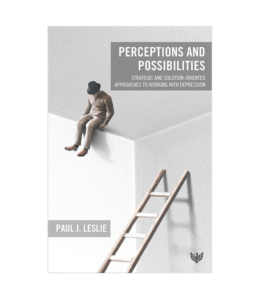
Dr. Paul J. Leslie is a psychotherapist, researcher, trainer, and author in Aiken, South Carolina. He specialises in resource-directed approaches to working with individuals and families, and is a licensed therapist in the states of Georgia and South Carolina, and a National Board Certified Fellow in Hypnotherapy. Paul has a doctorate in Counseling Psychology and is the coordinator of the psychology program at Aiken Technical College. He has authored nine books including Transforming Themes: Creative Perspectives on Therapeutic Interaction. His website is www.drpaulleslie.com.
Paul’s latest book, ‘Perceptions and Possibilities: Strategic and Solution-Oriented Approaches to Working with Depression’, is out on 15 September. Here, he expounds on how breaking familiar patterns of behaviour can help improve our practice.
In order to move forward and survive in life, we are all reliant upon the information we receive about our environment. We use this information to design our own mental maps which direct us in traversing our world. These mental maps are utilized to assess and corroborate our individual worldview, and any new information that we gain is filtered through a previously established worldview. This circular process (of new information confirming old information, which confirms new information…) forms habitual patterns of awareness in which our present perceptions about life often depend upon flawed primary perceptions. This process of perception can lead us to shape and maintain rigid and persistent patterns of cognition.
The brilliant mathematician George Spencer-Brown asserted that any act of creation involves the drawing of a distinction. This means that our perception of our world arrives when we draw a boundary. This suggests that the distinctions psychotherapy clients have drawn are what have created their perception about reality. This also suggests that their specific therapeutic situation can be changed when a new distinction is drawn by their therapist. The creation of new distinctions can aid in constructing new and empowering possibilities in the way clients perceive their lives. When distinctions are made, a boundary is then drawn between what is being described and what is not described (this / not this). This boundary splits the world into dichotomous categories which can limit the variety of ways clients can perceive their situations.
In order to effectively make new distinctions with clients, therapists need to discover the original distinction that clients have made about their situation. By being aware of how clients have come to “know” something, therapists can gain an understanding of how clients constructed their present perception of reality. If therapists are able to draw an alternative distinction that is then accepted by clients, the way clients “know” their situation can shift. A new distinction that is accepted by clients can alter their perception of their situation and allow openings for them to relate to their situation in new ways.
Since clients, who are drawing a distinction, are also simultaneously shaping what is being observed, therapists’ efforts to discover the root cause of problems might only assist in strengthening the “problem” being a problem. This is because any act of description of an observation is an act of making a distinction about what is being described, which leads to a circular process where descriptions and distinctions end up justifying each other and are then accepted as reality. The more the therapist and client discuss a “problem” using the original distinction made by the client, the more the problem becomes solidified in both the client’s and the therapist’s perception of reality. It is only when the therapist draws a new distinction in which the “problem” is no longer perceived the same way by the client can begin to exit their circular process of problem focus and become open to new possibilities.
For example, if a client states the reason he or she sought out therapy is due to “depression,” then the therapist will know that the client is making a distinction about what depression is and what it is not. Too often therapists will accept the original distinction provided by the client and work out of a limiting theme of “client has depression.” This ensures that the focus of therapy will be on eradicating depression, which may be difficult because that which we wish to obtain is usually tied to that we wish to eradicate (depression / no depression). However, if the therapist shifts the theme of therapy by drawing a new distinction about the client’s situation, then the client may be freed from his or her rigid perception of their experience. Therapists could offer a new distinction about the client’s depression such as it being an opportunity to slow down, a normal midlife shift, a signal to reconnect with one’s family, an inner call to embrace creativity, or the natural ebb and flow of life. If any of these new distinctions are accepted by the client, then therapy can exit the battleground of problem eradication and instead provide new possibilities for clients to experience their lives differently.
Paul J. Leslie
‘Perceptions and Possibilities: Strategic and Solution-Oriented Approaches to Working with Depression’, is out on 15 September. Pre-order your copy now!

